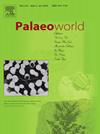中国云南东部曲靖中泥盆世腕足动物及其生物地层学和古生态学意义
IF 1.7
3区 地球科学
Q2 PALEONTOLOGY
引用次数: 0
摘要
首次对云南曲靖市东部中泥盆统曲靖地层进行了研究。在五台山地段,该地层的特征是含化石的石灰岩和泥灰岩,并伴有大量的陆相沉积。本研究采集了约 1292 个腕足动物个体标本和一些腕足动物碎片,并对其进行了系统鉴定。这些腕足动物被划分为 6 目 9 科 13 属 18 种,首次展示了这些物种及其详细的内部结构,并确定了一个新物种。我们发现了和-的集合体。华南中生代常见的Ⅳ和Ⅴ。而后者则出现在晚五代,主要包括小尺寸、光滑的螺旋足类(如、)和蝼蛄。该剖面的腕足类群在很大程度上与近滩地带的环境参数和生态因素有关,海平面的波动破坏了该地区碎屑岩和海相碳酸盐岩的交替沉积。在珊瑚礁和碳酸盐为主的基质中,腕足动物发生了有利的多样化,并被软底栖生物--腕足动物群所取代,而这一现象与 Givetian 地区多次、渐进的海平面波动相吻合。本文章由计算机程序翻译,如有差异,请以英文原文为准。
Middle Devonian brachiopods from Qujing of eastern Yunnan, China and their biostratigraphical and palaeoecological implications
The Middle Devonian Qujing Formation at its type locality in eastern Qujing City, Yunnan was investigated for the first time. At the Wutaishan section, the formation is characterized by fossiliferous limestone and marls with massive terrigenous inputs. About 1292 individual specimens and several fragmented stringocephalid brachiopods were collected and systematically identified in this study. They are assigned into 18 species of 13 genera from 9 families in 6 orders. Undispiriferoides species and their detailed internal structures are for the first time illustrated, with a new species Undispiriferoides qujingensis being established. We recognize the assemblages of Stringocephalus and Ambothyris-Spinatrypa. The former is characterized by Stringocephalus burtini and accompanied with plenty of Meristella kütsingensis, M. flayelli, and Desquamatia sp. that are commonly present in the middle Givetian in South China. Whereas the latter is identified in the late Givetian and mainly contains small-sized, smooth spiriferides (e.g., Emanuella takwanensis, Ambothyris panxiensis) and atrypides Spinatrypa. The brachiopod assemblages in the section were largely correlated with environmental parameters and ecological factors in the near-shoal belt, where alternating clastic and marine carbonate depositions were disrupted by sea-level fluctuations. The Stringocephalus fauna favorably diversified in reefal and carbonate-dominated substrates and was replaced by the soft-bottom dwelling habitants of the Ambothyris-Spinatrypa assemblage, coinciding with multiple and progressive sea-level fluctuations in the Givetian.
求助全文
通过发布文献求助,成功后即可免费获取论文全文。
去求助
来源期刊

Palaeoworld
PALEONTOLOGY-
CiteScore
4.00
自引率
5.90%
发文量
95
期刊介绍:
Palaeoworld is a peer-reviewed quarterly journal dedicated to the study of past life and its environment. We encourage submission of original manuscripts on all aspects of palaeontology and stratigraphy, comparisons of regional and global data in time and space, and results generated by interdisciplinary investigations in related fields. Some issues will be devoted entirely to a special theme whereas others will be composed of contributed articles. Palaeoworld is dedicated to serving a broad spectrum of geoscientists and palaeobiologists as well as serving as a resource for students in fields as diverse as palaeobiology, evolutionary biology, taxonomy and phylogeny, geobiology, historical geology, and palaeoenvironment.
Palaeoworld publishes original articles in the following areas:
•Phylogeny and taxonomic studies of all fossil groups
•Biostratigraphy, chemostratigraphy, chronostratigraphy
•Palaeoecology, palaeoenvironment and global changes throughout Earth history
•Tempo and mode of biological evolution
•Biological events in Earth history (e.g., extinctions, radiations)
•Ecosystem evolution
•Geobiology and molecular palaeobiology
•Palaeontological and stratigraphic methods
•Interdisciplinary studies focusing on fossils and strata
 求助内容:
求助内容: 应助结果提醒方式:
应助结果提醒方式:


